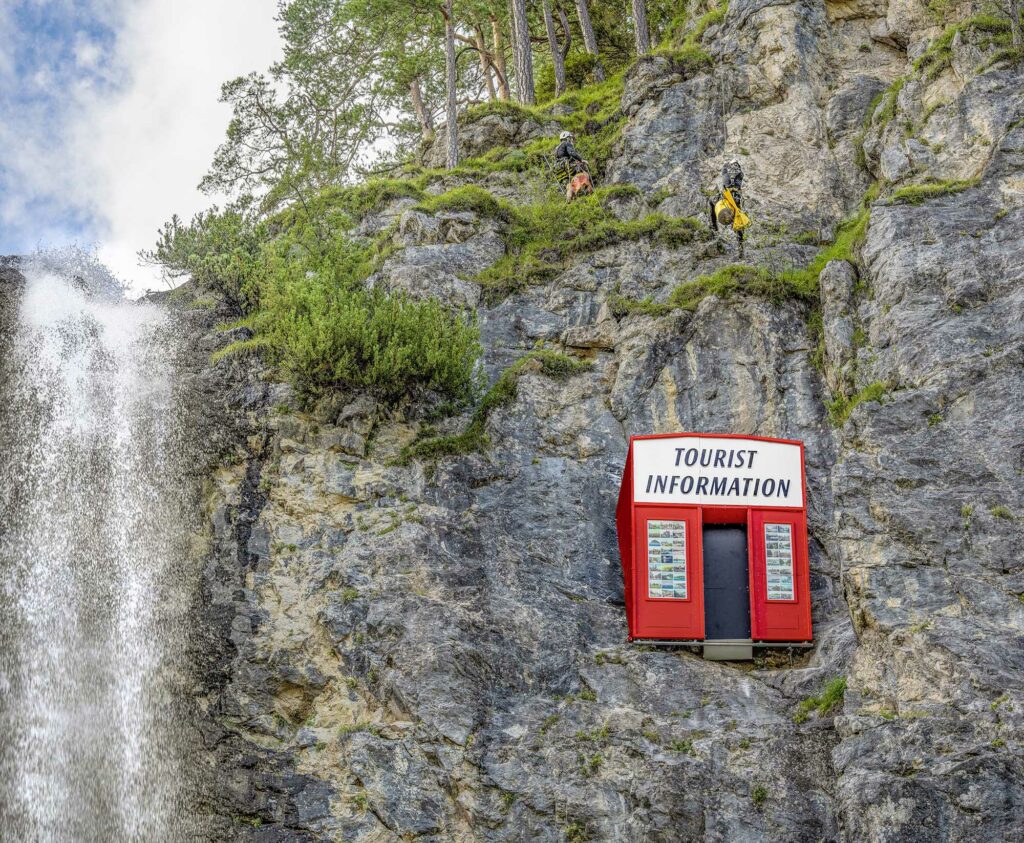Controversial Cliffhanger Installation That Ruins Perfect Alpine View To Be Removed In September
These images show a controversial art installation on the side of a picturesque Austrian cliff next to a waterfall that visitors complain has ruined the shot for tourists wanting to take pictures of the idyllic site.
Now the art installation, called “Cliffhanger”, which is located at the Mirafalls in the Austrian federal state of Lower Austria, on the Oetschergraeben River, in the Oetscher-Tormaeuer nature park, is due to be removed in September after causing outrage over the cost and allegations that it is spoiling the view.
The art installation, which consists of a large red fake doorway with “tourist information” written above it, was set up right next to the picturesque waterfall by a local Austrian art collective called Steinbrener, Dempf & Huber.

Florian Schublach, the head of the Oetscher-Tormaeuer nature park, which describes the beautiful site as the “Grand Canyon of Austria”, made up of “thundering waterfalls” and “unique nature” and which commissioned the controversial art installation, told Newsflash he thought it “was a really good idea”.
But a local hotel owner, who preferred to remain anonymous told Newsflash: “The installation on the waterfall was not a really good idea because many of the people who come up to visit us have complained.”
He added: “It was installed in late May 2020.”

He explained that tourists in particular are unhappy that they can no longer take good pictures of the waterfall without the red art installation being included in the shot. He also said that locals found the installation to be “unnecessary” and that the artists “got paid far too much for that”.
He said that they were paid “about EUR 70,000” (GBP 60,000). He said that “tourists come because of the nature, not to look at that. It’s in the way.”
He also explained that there is a QR code on signs on the path opposite the waterfall that people can scan to get more information about the installation. But he said that there is very poor telephone reception in the area, which stops people from accessing that information, adding: “You don’t have any Internet!”

He said that the money spent on setting it up would have been better spent on an environmental project geared towards protecting the beautiful location.
Asked what the solution would be, he said: “First, they have to remove the sign from up there and then they should set up signs with QR codes at the entrance to the site, where people can go online and obtain information about the environment.”
He also explained that every year, the footpaths, for example, “had to be repaired for tourists”, who would inevitably leave rubbish behind that needs to be cleaned up. With the coronavirus crisis, the area had experienced an increase in people coming to walk to the waterfall and that many of them “have no idea about nature”, littering and causing damage.

Schublach, however, said that “it was not intended to be a popular attraction. It was intended to be the opposite of a popular attraction. It was not set up to make a lot of people want to go there, more like the other way around.”
He suggested we speak to the artists. So Newsflash also contacted the Steinbrener, Dempf & Huber art collective and spoke to sculptor Christoph Steinbrener, 61.
Steinbrener said that the two other main members of the art collective are Rainer Dempf, 60, who is a photographer, and Martin Huber, 45, who is an architect.

Steinbrener said that the installation was actually meant as a critique of mass tourism, a tongue-in-cheek joke at the expense of tourists, and that it was there to ruin the shot for selfie-seeking tourists.
He explained: “During the week, there is nearly no one there and it is really a very, very nice, romantic place, but at the weekend it is the complete opposite. You have to stand in line and it is completely overcrowded. This, for us, is a sign of the times.”
He said that the installation is a “reflection on touristic overuse. For us, it was in a way perfect, this area, as every year, is completely overcrowded and in a way this sense of nature is lost.”

He said that he was delighted to learn that many tourists visiting the area make the waterfall the highlight of their hike and try to keep their art installation “out of shot when taking selfies”. He said that people visiting the site and seeing the installation could be split into two categories, those on the one hand who would exclaim “what the f*ck is this? This is a catastrophe!” and those who “understand what we meant”.
Steinbrener said that both reactions were exactly what they had been going for. The artist, who said that “humour is a good vessel for serious ideas”, did however confirm that the controversial art installation would be removed in September.
One of their early projects in 2005, which gained international recognition and made headlines in numerous newspapers, was called “Delete!”, and showed an entire street in the Austrian capital Vienna with every sign and brand name covered up. Steinbrener explained that their art collective was founded in 2005 with this seminal project geared towards critiquing advertising.

They also currently have an exhibition on at the Landesgalerie Niederoesterreich in the town of Krems, about one hour west of Vienna, called “We Are Everywhere – The Cliffhanger Collection”, which is geared towards explaining their Cliffhanger installation, with an emphasis on how pervasive people’s interest in taking selfies has become in the modern era.



